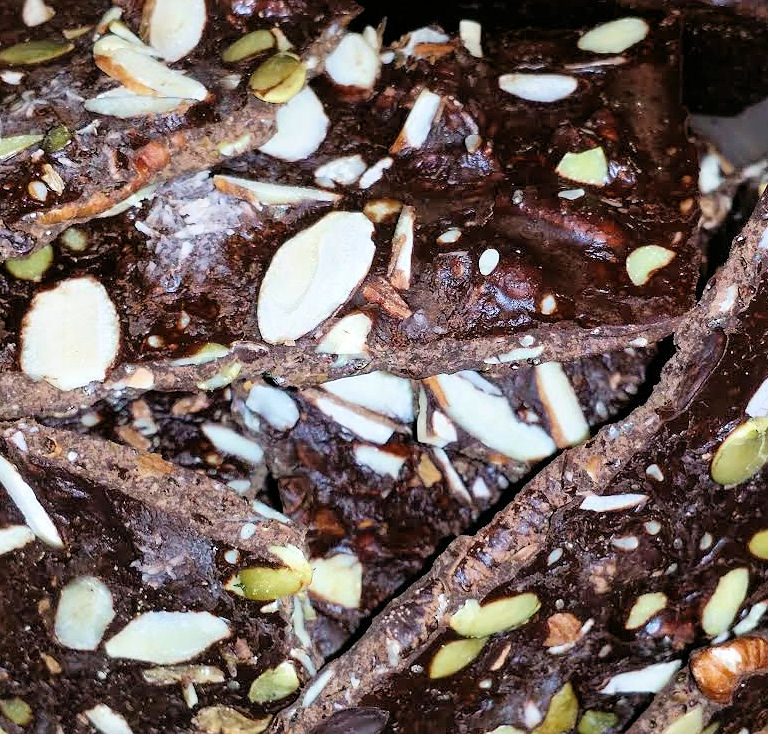The inspiration for this recipe comes straight from the Big Book of Sloth. I find the term 'superfood' to be too serious, so know that I use it with irony here. One of my kitchen cabinets is a disaster zone at present. Stuffed with way too many small containers of my bulk aisle treasures, containers now jump out and attack whenever we open the cabinet. Not cool, groceries, not cool. Clearly it was time to do some reorganizing, and maybe a little purging, too.
I was also craving chocolate and orange again, one of my favorite combos. Yet when I looked at my journal, I saw that I was once again short on healthy fats. "Get your head together," I chastised myself. "Healthy. Fats. Don't. Kill." I remembered having some dried fruit in chocolate bark ages ago. Why not use up some of these nuts and seeds?
100% raw cacao powder can be bitter if you aren't used to it. I wanted this chocolate bark to be Wahls Paleo Plus compliant with the potential to be used as a fat bomb. There is an option to add a sweetener, but skip it if you are on Paleo Plus. The orange zest, small squeeze of fresh orange juice, vanilla, and salt all help mellow some of the bitterness in the cacao. The salt and orange flavors also enhance the chocolate notes in the cacao. Salt is chocolate's best friend. Brownies without a touch of salt always disappointed me.
Yield: about a 10 x 10" square of chocolate bark; serving size determined by you
Ingredients
1 cup 100% raw cacao powder
1 cup virgin coconut oil (solid at room temperature)
1/2 cup mix of seeds plus 1 TBSP extra set aside for garnish: soaked and dried chia, flax, sesame, sunflower, pumpkin, and other Wahls-approved seeds. Note: All seeds should be dry when added to recipe.
1/2 cup mix of nuts plus 1 TBSP extra set aside for garnish: raw and chopped pecans, pistachios, cashews, walnuts, almonds (slivered especially), and other Wahls approved nuts. Note: All nuts should be dry when added to recipe.
1/2 cup shredded unsweetened coconut, plus 1 TBSP extra set aside for garnish
1 tsp kelp powder
2 tsp nutritional yeast
Zest of one large orange
2 TBSP freshly squeezed orange or clementine juice (optional)
2 tsp vanilla extract or powder
1/4 tsp sea or Himalayan salt plus 1/4 tsp extra set aside for garnish
1 tsp honey or maple syrup (optional; not for Paleo Plus)
1 cup virgin coconut oil (solid at room temperature)
1/2 cup mix of seeds plus 1 TBSP extra set aside for garnish: soaked and dried chia, flax, sesame, sunflower, pumpkin, and other Wahls-approved seeds. Note: All seeds should be dry when added to recipe.
1/2 cup mix of nuts plus 1 TBSP extra set aside for garnish: raw and chopped pecans, pistachios, cashews, walnuts, almonds (slivered especially), and other Wahls approved nuts. Note: All nuts should be dry when added to recipe.
1/2 cup shredded unsweetened coconut, plus 1 TBSP extra set aside for garnish
1 tsp kelp powder
2 tsp nutritional yeast
Zest of one large orange
2 TBSP freshly squeezed orange or clementine juice (optional)
2 tsp vanilla extract or powder
1/4 tsp sea or Himalayan salt plus 1/4 tsp extra set aside for garnish
1 tsp honey or maple syrup (optional; not for Paleo Plus)
Directions
- Select a baking sheet or casserole dish that will fit in your fridge or freezer. Line with parchment paper.
- Warm a small saucepan on the lowest setting on your stove for 1 to 3 minutes, until the bottom of the pan feels just a little bit hot. Turn off heat.
- Add coconut oil. Once melted, gradually whisk in raw cacao powder until the chocolate mixture is smooth and emulsified.
- Add kelp powder, nutritional yeast, orange zest, orange juice (optional), vanilla, and sweetener (optional). Whisk until all ingredients are incorporated smoothly into the chocolate mixture.
- Add nuts, seeds, and coconut gradually while whisking until the chocolate mixture is smooth.
- Taste chocolate mixture. Add sweetener, salt, or additional orange juice or zest if desired.
- Carefully pour and spread the chocolate mixture onto parchment. Using a spatula, spread the chocolate mixture so that it is about 1/4" inch thick or a little more. If you have created 'bald spots' in the chocolate mixture that are too thin or where the nuts and seeds are not distributed evenly, smooth with a spatula to correct any problems.
- Using the nuts, seeds, and shredded coconut set aside for garnish, sprinkle ingredients on the top of the chocolate mixture.
- Sprinkle the 1/4 tsp of salt on top of the garnish.
- Refrigerate or freeze chocolate bark for 12 to 24 hours. Bark should be hard and breakable.
- Peel parchment away from the bark.
- Break bark into small or larger pieces per your preference.
- Store bark in a sealed container.
- Keep in fridge to maintain shape.

